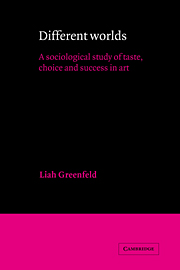Book contents
- Frontmatter
- Contents
- Introduction
- 1 Historical background
- 2 The population of painters and the split into subsystems
- 3 Patterns of success
- 4 The “gatekeepers” – critics
- 5 The “gatekeepers” – curators
- 6 The “gatekeepers” – gallery owners
- 7 The artists – attitudes of Conceptualists and Lyrical Abstractionists
- 8 The artists – attitudes of figurative painters
- 9 The publics
- 10 Conclusion
- Appendices
- Notes
- Index
- Titles in the series
7 - The artists – attitudes of Conceptualists and Lyrical Abstractionists
Published online by Cambridge University Press: 16 September 2009
- Frontmatter
- Contents
- Introduction
- 1 Historical background
- 2 The population of painters and the split into subsystems
- 3 Patterns of success
- 4 The “gatekeepers” – critics
- 5 The “gatekeepers” – curators
- 6 The “gatekeepers” – gallery owners
- 7 The artists – attitudes of Conceptualists and Lyrical Abstractionists
- 8 The artists – attitudes of figurative painters
- 9 The publics
- 10 Conclusion
- Appendices
- Notes
- Index
- Titles in the series
Summary
The interviews with art critics and museum curators show that in the art system to which they belong, artists, more than any other group, determine the criteria for the judgment of their art. In the end, the judged fulfill the role of the judges. Theoretically, the situation is not as absurd as it may, perhaps, seem. The artistic community may be capable of determining the criteria or norms of behavior for its members, prevent the acceptance of those who do not answer its requirements and guarantee thereby a high level of performance on the part of those who succeed in being accepted into it. This is the way of guaranteeing quality (which provides the basis for success) in different professional groups, this was the way to guarantee it in various craft guilds during the Middle Ages. Art also offers numerous examples of norms dictated by artistic communities to individual artists as well as to their clients (including art critics, museums, etc.). In certain cases such norms were no more than norms, namely, specific rules of behavior (Impressionism represents a remarkable example of such a case), in other cases they expressed important social values and explicitly demanded reference to them. The history of Israeli art provides us with such examples.
- Type
- Chapter
- Information
- Different WorldsA Sociological Study of Taste, Choice and Success in Art, pp. 126 - 135Publisher: Cambridge University PressPrint publication year: 1989



